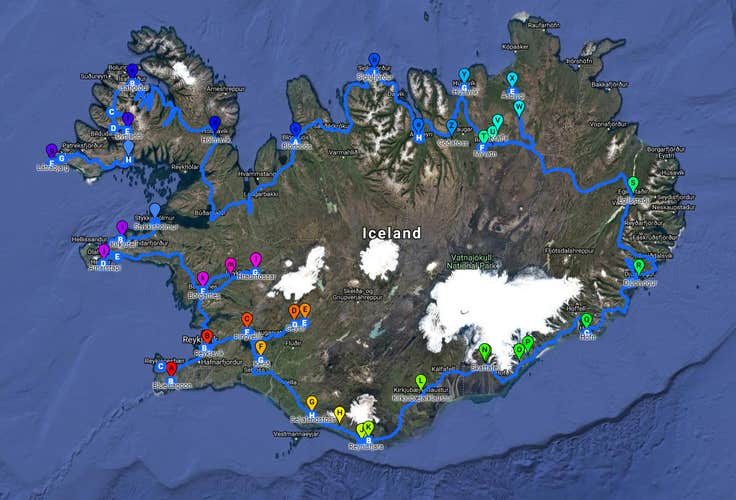14-dniowa budżetowa, samodzielna wycieczka po całej obwodnicy Islandii z Myvatn i Fiordami Zachodnimi





W cenie
Miejsca docelowe
Mapa
Atrakcje
Aktywności
Szczegóły podróży
Wybierz spośród najlepszych dostawców wynajmu samochodów w Islandii
Wybierz przejazd już teraz. Godzinę odbioru i szczegóły możesz ustalić w miarę zbliżania się terminu podróży.

Mały samochód

Średni samochód

Samochód premium

large car

SUV
Spersonalizuj plan podróży
Dzień 1 — Reykjavik
- Reykjavik - Dzień przybycia
- Więcej
- Reykjavik
- Kościół Hallgrimskirkja
- Ulica Laugavegur
- Rzeźba Sun Voyager
- Sala koncertowa Harpa
- Staw Tjörnin
- Stary Port
- Więcej
Pierwszego dnia, po wylądowaniu na międzynarodowym lotnisku w Keflaviku, odbierz wypożyczony samochód. Możesz jechać prosto do swojego zakwaterowania w Reykjaviku lub zatrzymać się po drodze w spa Blue Lagoon, które jest idealną opcją relaksu po długim locie. Ponieważ to bardzo popularne miejsce, zarezerwuj swój bilet wstępu z maksymalnie dużym wyprzedzeniem. Zrób to w momencie rezerwacji!
Następnie przejedziesz przez półwysep Reykjanes słynący z dużej aktywności geotermalnej i krajobrazów wypełnionych polami lawowymi i wulkanami.
Swoją pierwszą noc na Islandii spędzisz w Reykjaviku.
Noclegi 1 dnia
Wycieczki 1 dnia
Dzień 2 — Południowo-zachodnia Islandia
- Południowo-zachodnia Islandia
- Więcej
- Park Narodowy Thingvellir
- Laugarvatn
- Wodospad Bruarfoss
- Obszar geotermalny Geysir
- Wodospad Gullfoss
- Fludir
- Krater Kerid
- Więcej
Drugiego dnia wybierzesz się przez słynną trasę Złotego Kręgu zakładającą trzy najpopularniejsze atrakcje na wyspie. Pierwszym przystankiem będzie Park Narodowy Thingvellir, który został wpisany na listę UNESCO. Leży na styku dwóch płyt kontynentalnych i ma również znaczenie historyczne - to właśnie tutaj utworzono pierwszy demokratyczny parlament w 930 roku. Znajdziesz tam pola lawowe, wąwozy, pęknięcia oraz szczeliny wypełnione krystalicznie czystą wodą.
Kolejnym przystankiem będzie obszar geotermalny, na którym znajduje się potężny choć już nieaktywny Geysir oraz jego sąsiad - Strokkur, wyrzucający z siebie słup wody na wysokość kilkunastu metrów. Jego erupcje powtarzają się co kilka minut.
Trzecim przystankiem będzie malowniczy wodospad Gullfoss, jeden z najbardziej rozpoznawalnych i popularnych na Islandii. Ma 32 metry wysokości i spada podwójną kaskadą prosto do głębokiego kanionu. Szczęśliwie znajdziesz tam platformy widokowe, które bez wątpienia pomogą Ci w robieniu przepięknych zdjęć.
Stamtąd możesz dołączyć do trzech wycieczek. Pierwszą z nich są skutery śnieżne idealne dla wszystkich, których interesuje odrobina adrenaliny. Ta wycieczka startuje spod wodospadu Gullfoss i jest realizowana na lodowcu Langjökull. Jeżeli szukasz czegoś bardziej relaksującego możesz wybrać się na jazdę konno lub na snorkeling w szczelinie Silfra.
Dookoła Złotego Kręgu znajdziesz wiele wyjątkowych miejsc, które uwzględnimy w planie podróży. Jednym z nich jest na przykład krater Kerið - przepiękne miejsce pełne kolorów, intrygująco kontrastujących z otoczeniem.
Noc spędzisz w okolicy Selfoss.
Noclegi 2 dnia
Wycieczki 2 dnia
Dzień 3 — Południowe wybrzeże
- Południowe wybrzeże
- Więcej
- Wodospad Seljalandsfoss
- Wodospad Gljufrabui
- Wodospad Skogafoss
- Wodospad Kvernufoss
- Lodowiec Solheimajokull
- Dyrholaey
- Czarna piaszczysta plaża Reynisfjara
- Formacje skalne Reynisdrangar
- Vik
- Kościół Vik i Myrdal
- Więcej
Trzeciego dnia wybierzesz się przez południowe wybrzeże. To wyjątkowo piękna trasa, w trakcie której będziesz się wielokrotnie zatrzymywać. Znajdziesz tam słynne wodospady Seljalandsfoss i Skógafoss oraz mniej znany, ale równie malowniczy Gljúfrabúi, ukryty w jaskini.
Następnym przystankiem będzie jęzor lodowcowy Sólheimajökull, gdzie możesz spróbować dwóch aktywności - wędrówki po lodowcu lub skuterów śnieżnych.
Inną niezwykłą opcją jest eksplorowanie jaskini lodowej w lodowcu Mýrdalsjökull. Jest to jedyna tego rodzaju formacja dostępna przez cały rok, a jej niezwykła lokalizacja pozwala odwiedzającym na doświadczenie atrakcji, która w innych częściach Islandii jest otwarta dla turystów jedynie zimą.
Po wszystkim udasz się do spokojnej wioski Vik leżącej przy wybrzeżu. Możesz tam spacerować po czarnej plaży Reynisfjara (uważaj jednak na potężne fale, które łatwo mogą Cię porwać ze sobą) i oglądać ciekawe formacje skalne takie jak Reynisdrangar czy klify Dyrhólaey, na których mieszkają kolonie maskonurów.
Noc spędzisz w przytulnej wiosce Vik lub Kirkjubæjarklaustur (znanej również jako Klaustur).
Noclegi 3 dnia
Wycieczki 3 dnia
Dzień 4 — Południowo-wschodnia Islandia
- Południowo-wschodnia Islandia
- Więcej
- Kirkjubaejarklaustur
- Park Narodowy Vatnajokull
- Rezerwat przyrody Skaftafell
- Wodospad Svartifoss
- Laguna lodowcowa Fjallsarlon
- Laguna lodowcowa Jokulsarlon
- Diamentowa Plaża
- Hofn
- Więcej
Czwartego dnia czekają na Ciebie dwie wyjątkowe lokalizacje. Pierwszą z nich jest rezerwat Skaftafell, który leży tuż przy Parku Narodowym Vatnajökull. Otoczony jest potężnymi lodowcami i górami oraz polami lawowymi, lasami i rzekami. Koniecznie odwiedź wodospad Svartifoss, którego geologia jest fascynująca.
Jeżeli poprzedniego dnia nie udało Ci się dołączyć do wędrówki po lodowcu możesz wybrać się dzisiaj na lodowiec Skaftafellsjökull.
Skaftafell to naprawdę wyjątkowe miejsce, w którym spędzisz mnóstwo czasu. Polecamy jednak zarezerwować sobie popołudnie i wieczór na odwiedziny przy lagunie lodowcowej Jökulsárlón. Znajdziesz tam masywne góry lodowe bezwładnie pływające po głębokim jeziorze, szukające ujścia do oceanu. Oglądanie ich z brzegu to fascynujące zajęcie i świetna okazja do zrobienia przepięknych zdjęć. Dodatkowo możesz wybrać się na rejs po lagunie wybierając pomiędzy amfibią i szybką łodzią Zodiac.
Wypatruj również fok, które często pojawiają się w Jökulsárlón oraz wybierz na leżącą nieopodal Diamentową Plażę pełną czarnego piasku, na którym leżą krystaliczne, obmywane przez fale, bryły lodu.
Noc spędzisz w Höfn.
Noclegi 4 dnia
Wycieczki 4 dnia
Dzień 5 — Fiordy Wschodnie
- Fiordy Wschodnie
- Więcej
- Vestrahorn
- Góra Eystrahorn
- Djupivogur
- Wodospad Beljandi
- Wodospad Flögufoss
- Wodospad Folaldafoss
- Jezioro Lagarfljót
- Las Hallormsstadaskogur
- Wodospad Klifbrekkufossar
- Kanion Studlagil
- Seydisfjordur
- Kościół Seydisfjordur
- Egilsstadir
- Więcej
Piątego dnia wybierzesz się na odosobnione Fiordy Wschodnie, które stanowią jedną z najrzadziej uczęszczanych części Islandii. Znane są z wyjątkowych krajobrazów, których nie zobaczysz w innych regionach wyspy. Dodatkowo tylko tam żyją renifery. Przy odrobinie szczęścia zobaczysz również lisy arktyczne, maskonury i inne kolonie ptaków żyjących na klifach.
Po przejechaniu niezwykle malowniczej trasy, zobaczeniu jeziora Lagarfljót (w którym ponoć żyje potwór), noc spędzisz w największym mieście w tamtej części Islandii - Egilsstaðir.
Noclegi 5 dnia
Wycieczki 5 dnia
Dzień 6 — Północna Islandia
- Północna Islandia
- Więcej
- Wodospad Dettifoss
- Wodospad Selfoss
- Jökulsárgljúfur
- Obszar jeziora Myvatn
- Husavik
- Kanion Asbyrgi
- Wodospad Godafoss
- Kjarnaskogur
- Akureyri
- Ogród Botaniczny w Akureyri
- Kościół Akureyrarkirkja
- Więcej
Szóstego dnia dotrzesz do jeziora Myvatn, przejeżdżając przez Jökulsárgljúfur - część Parku Narodowego Vatnajökull. Po drodze zobaczysz jeden z największych wodospadów Europy - Dettifoss.
Kiedy znajdziesz się na miejscu, czeka na Ciebie kilka aktywności. Jezioro samo w sobie jest naprawdę przepiękne i stanowi dom dla wielu gatunków ptaków. Dodatkowo znajdziesz tam Dimmuborgir - intrygujące formacje lawy, wulkan z dymiącymi polami lawowymi Krafla czy chociażby jaskinię wykorzystaną przy kręceniu serialu “Gra o tron” - Grjótagjá. Spa Mývatn Nature Baths również jest warte odwiedzenia.
Jeżeli masz ochotę możesz wybrać się na oglądanie wielorybów w Husaviku, a nawet przedłużyć nieco rejs o obserwowanie maskonurów. Inną opcją jest niespieszne zwiedzanie terenów Myvatn.
Noc spędzisz w Akureyri.
Noclegi 6 dnia
Wycieczki 6 dnia
Dzień 7 — Północno-zachodnia Islandia
- Północno-zachodnia Islandia
- Więcej
- Fiord Eyjafjordur
- Półwysep Trolli
- Siglufjordur
- Hofsos
- Holar i Hjaltadal
- Skansen Glaumbær
- Saudarkrokur
- Blonduos
- Więcej
Siódmego dnia będziesz mieć możliwość zwiedzania stolicy północnej Islandii - Akureyri, w której znajdziesz wiele klimatycznych kafejek i restauracji, ciekawe butiki i ogród botaniczny. Możesz również wybrać się na poranne oglądanie wielorybów. Później rusz w stronę malowniczego fiordu Skagafjörður, podziwiając po drodze stada islandzkich koni, a następnie skieruj się na półwysep Tröllskagi.
Możesz odwiedzić starą wioskę rybacką Siglufjörður, w której znajdziesz nagradzane na świecie muzeum związane z historią połowów śledzi. Inną opcją jest wybranie się do wioski Hofsós, gdzie masz okazję spróbować kąpieli w przepięknym geotermalnym basenie z rewelacyjnymi widokami na wybrzeże.
Noc spędzisz w Saudarkrokur.
Noclegi 7 dnia
Wycieczki 7 dnia
Dzień 8 — Fiordy Zachodnie
- Fiordy Zachodnie
- Więcej
- Kościół Þingeyrakirkja
- Bazaltowe formacje i ruiny Borgarvirki
- Skała Hvitserkur
- Hvammstangi
- Holmavik
- Więcej
Ósmego dnia ruszysz na zapierające dech Fiordy Zachodnie, które zwykle są omijane przez większość turystów. Po drodze zobaczysz wiele miejscowości, w których warto się zatrzymać, między innymi w Borgarvirki czy przy wystających z oceanu skałach Hvítserkur, które wyglądają jak pijący wodę smok lub słoń.
W Hólmaviku znajdziesz Muzeum Magii i Czarodziejstwa oraz dowiesz się nieco o islandzkiej magii praktykowanej kiedyś na tych terenach. Jeżeli masz ochotę na relaksującą kąpiel wybierz się do Drangsnes.
Noc spędzisz w regionie Strandir.
Noclegi 8 dnia
Wycieczki 8 dnia
Dzień 9 — Fiordy Zachodnie
- Fiordy Zachodnie
- Więcej
- Sudavik
- Bolungarvik
- Muzeum Morskie Osvor
- Isafjordur
- Więcej
Dzisiaj przejedziesz przez spektakularne Fiordy Zachodnie, które powitają Cię potężnymi górami, majestatycznymi fiordami i klimatem niedostępnym w żadnej innej części Islandii. Co jakiś czas przyglądaj się wodzie - często znajdują się w niej foki lub wieloryby.
Kiedy dotrzesz do Ísafjörður może będziesz mieć ochotę na zwiedzanie leżącej niedaleko wioski Bolungarvik, gdzie znajdziesz muzeum morskie Ósvör opowiadające historię tamtych terenów.
Noc spędzisz na terenie Ísafjarðardjúp.
Noclegi 9 dnia
Wycieczki 9 dnia
Dzień 10 — Fiordy Zachodnie
- Fiordy Zachodnie
- Więcej
- Molo w Onundarfjordur
- Dynjandi
- Hrafnseyri
- Latrabjarg
- Plaża z czerwonym piaskiem Raudisandur
- Patreksfjordur
- Basen Hellulaug
- Więcej
Dzisiaj wybierzesz się do dwóch niesamowitych miejsc znajdujących się na islandzkich Fiordach Zachodnich. Pierwszym z nich jest wodospad Dynjandi, drugim zaś klify Latrabjarg stanowiące również najdalej wysunięty na zachód punkt Islandii. To także królestwo ptaków, w szczególności maskonurów, które w większości przypadków nie boją się ludzi. To perfekcyjna lokalizacja do fotografowania tych ptaków!
Po wszystkim udasz się do Patreksfjörður, gdzie spędzisz noc.
Noclegi 10 dnia
Wycieczki 10 dnia
Dzień 11 — Półwysep Snaefellsnes
- Półwysep Snaefellsnes
- Więcej
- Stykkisholmur
- Góra Kirkjufell
- Wodospad Kirkjufellsfoss
- Czarna kamienista plaża Djupalonssandur
- Dritvík
- Bazaltowe klify Londrangar
- Więcej
Dzisiaj wyruszysz z Fiordów Zachodnich wprost na półwysep Snaefellsnes, korzystając z promu Baldur płynącego do wioski Stykkishólmur. Cena za bilet promowy jest zawarta w tej wycieczce i możesz zabrać ze sobą, bez dodatkowych kosztów, również samochód.
Snaefellsnes ma 90 kilometrów długości i nazywany jest często “Islandią w miniaturze” ze względu na przepiękny i mocno zróżnicowany krajobraz. Ważnymi miejscami na półwyspie jest Park Narodowy Snæfellsjökull, góra Kirkjufell, wioski rybackie Arnarstapi i Hellnar oraz czarna, kamienista plaża Djúpalónssandur.
Noc spędzisz na półwyspie Snaefellsnes..
Noclegi 11 dnia
Wycieczki 11 dnia
Dzień 12 — Półwysep Snaefellsnes
- Półwysep Snaefellsnes
- Więcej
- Snaefellsjokull
- Miejscowość Arnarstapi
- Skała Gatklettur
- Wąwóz Raudafeldsgja
- Wodospad Bjarnarfoss
- Wioska Budir
- Kościół Budir
- Plaża Ytri Tunga
- Więcej
Dwunasty dzień swojej podróży spędzisz na odwiedzaniu miejsc, które zostały pominięte poprzedniego dnia. Możesz wybrać się na plażę Ytri-Tunga, która stanowi dom dla kolonii fok, do jaskini lawowej Vatnshellir, odwiedzić czarny kościół w Búðir i zobaczyć malownicze bazaltowe kolumny Lóndrangar. Innymi miejscami wartymi zobaczenia jest jezioro Bárðarlaug leżące niedaleko Hellnar.
Drugą noc spędzisz na półwyspie Snaefellsnes.
Noclegi 12 dnia
Wycieczki 12 dnia
Dzień 13 — Reykjavik
- Reykjavik
- Więcej
- Gorące źródło Deildartunguhver
- Reykholt — Miejsce historyczne
- Wodospady Hraunfossar i Barnafoss
- Borgarnes
- Reykjavik
- Więcej
Przedostatniego dnia wycieczki wyruszysz do Reykjaviku, odwiedzając po drodze kilka miejsc.
Dotrzesz do wodospadów Hraunfossar i Barnafoss, które znajdują się niedaleko siebie. Hraunfossar spływa wprost z pól lawowych, natomiast Barnafoss leży w kanionie. Niedaleko nich znajdziesz również najwyżej płynące gorące źródło w Europie - Deildartunguhver. Fani historii powinni odwiedzić wioskę Reykholt, w której znajdą muzeum Snorrastofa zadedykowane Snorriemu Sturlusonowi - najważniejszemu średniowiecznemu pisarzowi. Dodatkowo zatrzymasz się w Borgarnes, w muzeum osadnictwa.
Zanim dotrzesz do Reykjaviku masz okazję uczestniczyć w 2 wyjątkowych atrakcjach. Pierwszą z nich jest wybranie się do jaskini lawowej Viðgelmir, drugą eksplorowanie tuneli w lodowcu Langjökull.
Kiedy znajdziesz się w Reykjaviku, możesz również skorzystać z wycieczki eksplorowania komory magmowej w wulkanie Thrihnukagigur, co stanowi jedyną na świecie tego typu aktywność.
Noc spędzisz w Reykjaviku
Noclegi 13 dnia
Wycieczki 13 dnia
Dzień 14 — Reykjavik
- Reykjavik - Dzień wyjazdu
- Więcej
- Krysuvik
- Basen w lawowej skale Brimketill
- Gunnuhver
- Valahnukamol
- Latarnia Reykjanesviti
- Most Między Kontynentami
- Klify morskie Hafnarberg
- Więcej
Niestety to już ostatni dzień Twoich wakacji na Islandii. Odstaw wypożyczony samochód na międzynarodowym lotnisku w Keflaviku przed swoim wylotem. Osoby, które mają późniejszy lot i zdecydują się odwiedzić Błękitną Lagunę, zakończą swój pobyt na Islandii odprężając się w ciepłych, lazurowych wodach spa przed wyruszeniem na lotnisko.
Możesz także odwiedzić czarną plażę przy latarni Grótta, przejść się przez Elliðarárdalur lub odwiedzić kościół Hallgrímskirkja i popularny budynek Perlan, aby podziwiać panoramę miasta.
Spokojnej podróży!
Wycieczki 14 dnia
Jak to działa
Zarezerwuj swoją wycieczkę na najlepszej islandzkiej platformie turystycznej — otrzymasz natychmiastowe potwierdzenie, gwarancję najlepszej ceny i całodobowe lokalne wsparcie.
Zarezerwuj swoje miejsce
Otrzymaj natychmiastowe potwierdzenie
Spersonalizuj plan podróży
Skorzystaj z wiedzy ekspertów
Uzyskaj dostęp do Klubu VIP
Podróżuj bez stresu
Co zabrać
Warto wiedzieć
Samodzielne wycieczki rozpoczynają się w mieście Reykjavík lub na międzynarodowym lotnisku w Keflaviku. Wymagane jest ważne prawo jazdy oraz roczne doświadczenie na drodze. Należy pamiętać, że plan podróży może zostać zmieniony, aby lepiej pasował do daty i godziny przyjazdu. Ubezpieczenie GP dla wynajętego samochodu (od uszkodzeń na drogach szutrowych) nie jest uwzględnione, jeśli wybierzesz samochód typu Toyota Aygo lub podobny.
Niektóre opcjonalne atrakcje mogą wymagać posiadania ważnego prawa jazdy lub przesłania dodatkowych informacji do organizatora podróży. Należy pamiętać, że może być konieczne przedstawienie dokumentów medycznych, jeśli zdecydujesz się na snorkeling lub nurkowanie, a uczestnicy muszą czuć się komfortowo w wodzie i umieć pływać.
Chociaż jest lato, islandzka pogoda może być bardzo nieprzewidywalna. Prosimy o zabranie odpowiedniej odzieży.
Noszenie bawełny lub dżinsów jako warstwy zewnętrznej podczas wycieczki na wulkan Þríhnjúkagígur jest niedozwolone. Na tę wycieczkę należy założyć odpowiednią wodoodporną odzież i solidne buty turystyczne. Wewnątrz krateru panuje zawsze taka sama temperatura — około 5-6°C. Wycieczka na wulkan Þríhnjúkagígur obejmuje wędrówkę o długości około 3 km w każdą stronę. Spacer trwa zwykle około 45-50 minut (w zależności od kondycji osób w grupie). Przewodnik będzie Ci towarzyszył przez całą wycieczkę.
Video
Gwarantujemy
Twoja podróż jest zabezpieczona, dostosowana do Twoich potrzeb i uczciwie wyceniona. Bez niespodzianek, bez stresu.
Zweryfikowane opinie
Podobne pakiety wakacyjne

Pobierz największą platformę turystyczną na Islandii na telefon i zarządzaj wszystkimi elementami swojej podróży w jednym miejscu
Zeskanuj ten kod QR za pomocą aparatu w telefonie i naciśnij wyświetlony link, aby uzyskać dostęp do największej platformy turystycznej na Islandii. Wprowadź swój numer telefonu lub adres e-mail, aby otrzymać wiadomość SMS lub e-mail z linkiem do pobrania.







